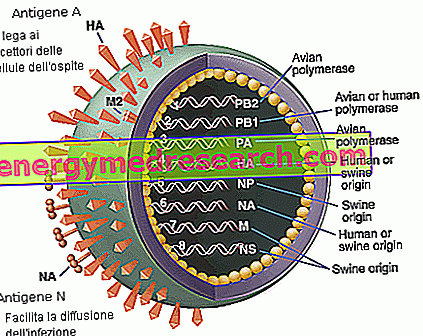Generality
The swine flu (IS or Pig Flu for the Anglo-Saxons) is an acute respiratory disease, of an infectious nature, caused by influenza viruses of type A. It is characterized by the sudden onset and a set of symptoms that includes cough, dyspnea ( difficult breathing), fever and prostration (physical weakness). In uncomplicated forms, healing from influenza A is rapid and complete. Equally rapid is the development of lesions, which remain circumscribed to the respiratory system and which, in most cases, regress completely. The most serious forms of acute pneumonia, which can be fatal, are exceptions.
Insights
HistoryMutation of the influenza virus ASintomiTreatmentThe flu virusInterspecies transmissionComplicationsVaccination for H1N1Contraindications and adverse reactions to vaccinationHistory
The swine flu is not a "new" influence, as some authors claim; it has been a subject of particular interest since its first description in 1918. In the late summer of that year, in the pig farms of the north-central United States, a new disease manifested itself, clinically very similar to human influence, which in the same year he appeared in pandemic form causing around 20 million deaths worldwide. Exact place and date of the first appearance are still unknown, but scholars have established that the first cases appeared in August 1918 in western Illinois farms. It is probable that the disease was present in pigs before this date, but that it had not yet been noticed and described. The dr. JS Koen, inspector of the classical swine fever inspection service of the Animal Industries Office of the Department of Agriculture, was the first to state, in 1922, that the pathology was different from all those previously observed; he was particularly struck by the coincidence with the epidemic in humans and the overlap between human and pig symptoms. He was convinced that it was not a question of two diseases and was the first to use the name "flu" ( flu ) also in pigs, concluding that pigs had been infected by humans, probably by breeders or veterinarians working in that area . The different aspects of the disease, such as the course, symptoms and injuries, were accurately described in the following decade, but it was only in 1930 that Shope isolated and identified the responsible virus; he dealt with the subject for 25 years.
In any case, from 1918 to the present, the characteristics of the infection and the swine flu in the north-central part of the United States have not changed: the agents that cause it are some influenza viruses of type A, different from each other for some characteristics .
How is an influenza virus made?
Swine flu is caused by influenza viruses of type A. Influenza viruses belong to a family called Orthomyxoviridae, they are very small and have a spherical shape, similar to a "chestnut hedgehog". They consist of:
- a central portion, which is called core, containing RNA (ribonucleic acid) in the shape of a helix, enzymes and proteins (among which the most important from an antigenic point of view is the protein S ). The viral genome (and therefore the RNA) is divided into 8 separate fragments, each corresponding to a gene. These 8 genes give (code) 10 proteins. Genome fragmentation is the basis of genetic exchange and recombination during mixed infections. The genetic reassortment between human and animal viruses is considered a determining factor in the formation of new pandemic human viral strains. Influenza viruses are classified as A, B or C based on the S antigen, which is different in each of the three categories (it is said to be type-specific);
- a protein matrix external to the core, containing an antigen (that is, a protein capable of effectively activating the immune response) called protein M ;
- an external envelope formed by lipids, called envelope, with thorn-like extroflections called "spikes", which are proteins incorporated between the lipids and endowed with a strong antigenic power. These proteins are hemagglutinin (or H antigen) and neuraminidase (or N antigen).

Neuraminidase (AN) causes its elution and can play an important role in the release of new viral particles from infected cells, but also stimulates the formation of protective antibodies that inhibit the release of viral particles (originating from the replication of the virus) from them infected cells. In the influenza viruses of type A 13 hemagglutinins and 9 neuraminidases have been identified; the current system of naming influenza viruses has been in use since 1980 and defines type, host, place of origin, year of isolation and antigenic subtype. For example, a virus isolated from the pig in Wisconsin during 1984 should be designated as A / swine / Wis / 84 (H1N1). The first letter (A) identifies the type, and is followed by the animal species concerned (swine), which in the case of man is omitted, from the geographical origin (Wis), from the number of stem, if there is (84), from the year of isolation and from the antigenic subtype H and N, placed in brackets (H1N1). Before 1980 swine flu viruses were referred to as Hsw1N1.
Most cases of swine flu are caused by H1N1.
See also: Nutrition, medicinal herbs and flu




